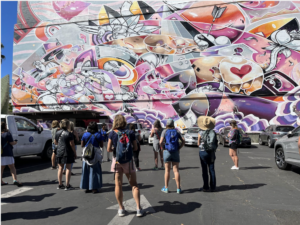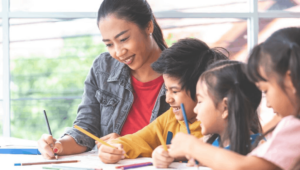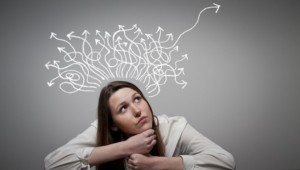Metacognition and Why it Matters in Education

An important part of learning and teaching is the art of reflection. As teachers, we need to be reflective in our practice so that we can continue to grow, be prepared to meet our students’ needs, and evaluate our own skills and growth. It is important that we model this same practice for our students so that they can develop their own reflective practices and build skills of metacognition in preparation for their future. Metacognition enables students to reflect on who they are, what they know, what they want to know, and how they can get to that point. I’m not an expert but this is a topic that I’ve become more interested in so I started to look into multiple resources to learn more.
What is metacognition?
Metacognition, a term that was first defined by John H. Flavell in 1979, is basically thinking about thinking. With metacognition, we become aware of our own learning experiences and the activities we involve ourselves in our paths toward personal and professional growth. We are better able to understand ourselves in the whole process of learning and can develop skills to think about, connect with, and evaluate our learning and interactions each day. But how and why is metacognition important in education?
It has been identified as an essential skill for learner success. Therefore, do we need to design specific lessons focused on metacognition for use in our classrooms each day? And if so, how can we make this happen?
From the beginning of the school year, I noticed some responses from students when it came to learning, the struggle of learning, and making mistakes. I also noticed that many times students were okay with avoiding an answer or accepting that the answer given was incorrect and did not push themselves to understand why or how to improve. It made me wonder if we need to be more intentional about working with our students on metacognition each day and how can we include it in our teaching practice. My initial reaction is that it does and while I feel as though it is something that I have been doing, I need to be more intentional and consistent about doing more to promote metacognition with my students.
It starts with us
As educators, we need to be able to identify personal strengths and weaknesses in our teaching practice and think about them so that we can best provide for our students. We need to guide students to develop these same skills by modeling it for them and then by supporting them as they build their own metacognitive practices. With an increased focus on the importance of developing skills in social-emotional learning (SEL), metacognition plays an important part in the SEL framework. Through resources such as CASEL, which sets forth the five areas of focus for social-emotional learning, we can now learn more about how to find the right resources and the best strategies for helping our students develop these essential skills.
For our students to be successful in the future, they need opportunities to develop skills that are transferable beyond high school to do whatever it is that they ultimately decide to do once they graduate. They need to be able to self assess their needs in learning, areas of potential weaknesses and identify their strengths. Students then need to know how to use this information to plan their next steps. While the world of work will continue to change, some of the essential skills that students will need the most will stay the same. Skills like the ability to set one’s own goals, to problem solve, to analyze the tasks that they have before them, and to evaluate any challenges that might come along the way. These skills are in alignment with the three phases of metacognition: planning, monitoring, evaluating. Each of these is essential in the learning process and students need to learn how to reflect and to self-direct to the next steps.
What does it look like in the classroom?
In my classroom, something that I have noticed more each year is that students often possess self-doubt and lack of confidence in responding in class. When called upon to respond, students try to avoid answering by saying “I don’t know, I won’t get it, I can’t do it.” Any of these statements are often followed by “please call on someone else.” By avoiding the chance of being wrong, or extending the conversation, it does not help students to understand exactly what it is they don’t know, why they don’t know it, and how to push through to figure it out. I’ve been there. Even as an adult and educator, I struggle with this at times. But the difference is that I can push through it because I think back to my own experiences and try to relate to my own students that it is in our control to take the steps we need to go beyond the “I don’t know.” We have to say “I don’t know…yet.”
Following the “Power of Not Yet,” by Carol Dweck, we need to place emphasis on adding that one word to the end of those statements and helping students to self-assess and determine how they can get there.
Strategies to promote metacognition
- Relationships: I believe that it starts with building relationships that are supportive and which promote two-way conversations in the classrooms. Creating a space where students feel comfortable answering and making a mistake, where failures are expected and welcomed as a boost to the learning experience, and where teachers model the same for students.
- Think aloud: Sometimes I have just talked one-to-one with the student and asked them to share what they know. Giving students the chance to think through it with you, or by rephrasing the question, can be a simple way to help them push through that productive struggle and develop their own strategies for when they feel that same sense of doubt.
- Share ideas: I try to share learning strategies and ways to help students question their learning process, figure out how they learn best, try different strategies and then take time to think through how a particular one worked for them or didn’t. Sometimes helping students to identify their learning style will lead to a quick boost in confidence and build self-confidence in learning.
- Resources: There are many strategies for metacognition. Catlin Tucker shared four strategies for metacognitive thinking and how to get students to think about their learning. These are easy to get started with and provide a way for students to build comfort in sharing their learning and help us identify some areas they might need some help with. Ideas include SMART goal setting (Specific, Measurable, Attainable, Relevant, and Timely), weekly exit slips, video response or reflection tools, and ongoing self-assessment documents. For these, I think of using things like Google Forms, Flipgrid, Synth, or a tool like Kidblog for student reflections. There are many strategies available for educators to get started.
- Visible thinking: Help students to make thinking visible. Whether using an outline with questions or prompts and having students fill in their thoughts or trying a strategy like sketchnoting, where students can jot down ideas and make connections to learning, these can be beneficial for all learners. Some other strategies like Think, Pair, Share, or “I used to think…but now I think…” and others that have students interact with peers and also build on prior knowledge are helpful for students to build metacognitive skills.
Regardless of the method we choose, the end goal is the same: to empower students to drive their learning, build student agency, and foster a growth mindset in learning. We start by providing the right support, share our own experiences whether we struggled or we’ve had success, and showing our authentic selves to our students. There are resources available like Benchmark Education, or posts which share example prompts we can use to get started. It is important that we help students understand that who they are now does not define them for the future; meaning that mistakes or areas of weakness in learning are just starting points for our learning journey. Metacognition is critical for helping students work through these challenges and when we model and integrate self-assessment, look at prior knowledge, and then evaluate what we need to know and determine our next steps, we build those metacognitive skills.
For more, see:
- Metacognition and Mindfulness Meet the Power of Not Yet!
- Mapping 21st-Century Skills to SEL Competencies
- Why Students Need Practical Skills and How to Teach Them
- How Digital Portfolios Empower Student Ownership of Learning
Stay in-the-know with innovations in learning by signing up for the weekly Smart Update.





Patti Shade
We must uncover what lies beneath. A favorite question to ask students, “Tell me your thinking.”
#CreativityandInnovationSkills
#21stCenturyLearning
#CreativeAgentsofChange
MERCY BALEAN BITBIT
thank You